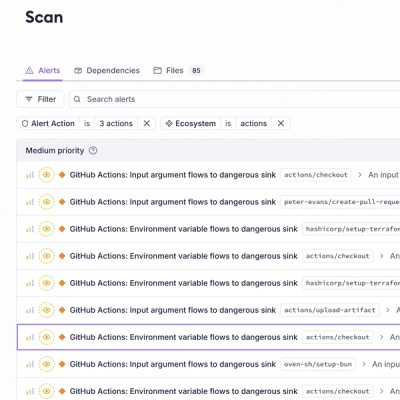
Product
Introducing Socket Firewall Enterprise: Flexible, Configurable Protection for Modern Package Ecosystems
Socket Firewall Enterprise is now available with flexible deployment, configurable policies, and expanded language support.

Shunter is a Node.js module built to read JSON and translate it into HTML.
It helps you create a loosely-coupled front end application which can serve traffic from one or more back end applications — great for use in multi-language, multi-disciplinary teams, or just to make your project more flexible and future-proofed.
Shunter does not contain an API client, or any Controller logic (in the MVC sense). Instead, Shunter simply proxies requests to a back end server, then:
If the back end wants Shunter to render the response, it returns the application state as JSON, served with a certain HTTP header. This initiates the templating process in Shunter.

If the back end wishes to serve the response, it omits the header and Shunter proxies the request back to the client.

Shunter is also able to serve resources like CSS, JS, or images bundled with the templates as part of your application.

You can find all the details about how to use Shunter in our documentation. If you're new to Shunter, we recommend reading the Getting Started Guide. This will teach you the basics, and how to create your first Shunter-based application.
The latest version of Shunter requires Node.js v12-16.
See the Getting started documentation for more information on Shunter's requirements.
Instructions for installing Node.js are available on their website.
Shunter supports various versions of Node.js:
| Major Version | Last Feature Release | Node Versions Supported |
|---|---|---|
| 5 | N/A | >=12 <=16 |
| 4 | 4.13 | >=4 <=8 |
| 3 | 3.8 | >=0.10 <=5 |
Versions 1 and 2 of Shunter were not public releases.
If you're migrating between major versions of Shunter, we maintain a migration guide to help you.
If you'd like to know more about how we support our open source projects, including the full release process, check out our support practices document.
We'd love for you to contribute to Shunter. We maintain a guide to help developers get started with working on Shunter itself. It outlines the structure of the library and some of the development practices we uphold.
We also label issues that might be a good starting-point for new developers to the project.
Shunter is licensed under the Lesser General Public License (LGPL-3.0).
Copyright © 2025, Springer Nature
5.0.0 (2025-03-05)
5.0.0-rc1 ... 5.0.0-rc5 omitted from this document
FAQs
A Node.js application built to read JSON and translate it into HTML
The npm package shunter receives a total of 772 weekly downloads. As such, shunter popularity was classified as not popular.
We found that shunter demonstrated a healthy version release cadence and project activity because the last version was released less than a year ago. It has 8 open source maintainers collaborating on the project.
Did you know?

Socket for GitHub automatically highlights issues in each pull request and monitors the health of all your open source dependencies. Discover the contents of your packages and block harmful activity before you install or update your dependencies.

Product
Socket Firewall Enterprise is now available with flexible deployment, configurable policies, and expanded language support.

Security News
Open source dashboard CNAPulse tracks CVE Numbering Authorities’ publishing activity, highlighting trends and transparency across the CVE ecosystem.

Product
Detect malware, unsafe data flows, and license issues in GitHub Actions with Socket’s new workflow scanning support.